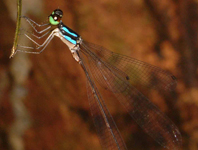Abstract
The New Zealand diplodactylid gecko genus Toropuku is currently monotypic, but the sole member of the genus, T. stephensi, is distributed in two disjunct, geographically distant regions of New Zealand – the islands of Cook Strait (which includes the type locality, Stephens Island), between New Zealand’s North and South Islands, and the Coromandel Peninsula, in the northeastern North Island. Previously published phylogenetic results, based on three total individuals, recognized substantial—possibly species-level—diversity between these disparate localities, although no taxonomic decisions were made at that time. More recently, additional animals have been found on the Coromandel Peninsula. We here present phylogenetic and morphological evidence based on this expanded dataset to formally describe the populations on the Coromandel Peninsula as a new species, Toropuku inexpectatus sp. nov. The specific epithet refers to the species’ surprise discovery in a herpetologically well-surveyed area. The recognition of T. inexpectatus sp. nov. as a distinct species has implications for the conservation status of T. stephensi, which is now considered restricted to three islands in Cook Strait.
References
Chapple D.G., Daugherty C.H. & Ritchie P.A. (2008) Comparative phylogeography reveals pre-decline population structure of New Zealand Cyclodina (Reptilia: Scincidae) species. Biological Journal of the Linnean Society, 95, 388–408.
https://doi.org/10.1111/j.1095-8312.2008.01062.x
Chapple, D.G., Ritchie, P.A. & Daugherty, C.H. (2009) Origin, diversification, and systematics of the New Zealand skink fauna (Reptilia: Scincidae). Molecular Phylogenetics and Evolution, 52, 470–487.
https://doi.org/10.1016/j.ympev.2009.03.021
Cree, A. (1990) Ecology of the Stephens Island gecko. Unpublished report, School of Biological Sciences, Victoria University of Wellington, Wellington, 16 pp., figs.
Gray J.E. (1842) Descriptions of some new species of reptiles, chiefly from the British Museum collection. Zoological Miscellany, 1842, 57–59.
Hitchmough, R.A. (1997) A systematic review of the New Zealand Gekkonidae. Unpublished PhD thesis, Victoria University of Wellington, Wellington, 371 pp.
Hitchmough, R.A., Hoare, J.M., Jamieson, H., Newman, D., Tocher, M.D., Anderson, P.J., Lettink, M. & Whitaker, A.H. (2010) Conservation status of New Zealand reptiles, 2009. New Zealand Journal of Zoology, 37, 203–224.
https://doi.org/10.1080/03014223.2010.496487
Hitchmough, R., Anderson, P., Barr, B., Monks, J., Lettink, M., Reardon, J., Tocher, M. & Whitaker, T. (2013) Conservation status of New Zealand reptiles, 2012. New Zealand Threat Classification Series 2.Department of Conservation, Wellington, 16 pp.
Hitchmough, R., Barr, B., Lettink, M., Monks, J., Reardon, J., Tocher, M., van Winkel, D. & Rolfe, J. (2016) Conservation status of New Zealand reptiles, 2015. New Zealand Threat Classification Series 17. Department of Conservation, Wellington, 14 pp.
IUCN (2012) IUCN Red List Categories and Criteria: Version 3.1. 2nd Edition. IUCN, Gland and Cambridge, iv + 32 pp.
McCann, C. (1955) The lizards of New Zealand. Gekkonidae and Scincidae. Dominion Museum Bulletin, 17, 1–127.
Miller, M.A., Pfeiffer, W. & Schwartz, T. (2010) Creating the CIPRES Science Gateway for inference of large phylogenetic trees. Proceedings of the Gateway Computing Environments Workshop (GCE), New Orleans, Louisiana, 14 November 2010, 1–8.
https://doi.org/10.1109/GCE.2010.5676129
Morgan-Richards, M., Rheyda Hinlo, M., Smuts-Kennedy, C., Innes, J., Ji, W., Barry, M., Brunton, D. & Hitchmough, R.A. (2016) Identification of a rare gecko from North Island New Zealand, and genetic assessment of its probable origin: a novel mainland conservation priority? Journal of Herpetology, 50, 77–86.
https://doi.org/10.1670/13-128
Nelson, N.J., Romijn, R.L., Dumont, T., Reardon, J.T., Monks, J.M., Hitchmough, R.A., Empson, R. & Briskie, J.V. (2016) Lizard conservation in mainland sanctuaries. In: Chapple, D.G. (Ed.), New Zealand Lizards. Springer International Publishing, Cham, pp. 321−339.
https://doi.org/10.1007/978-3-319-41674-8_12
Newman, D.G. (1994) Effects of a mouse, Mus musculus, eradication programme and habitat change on lizard populations of Mana Island, New Zealand, with special reference to McGregor’s skink, Cyclodina macgregori. New Zealand Journal of Zoology, 21 (4), 443–456.
https://doi.org/10.1080/03014223.1994.9518015
Nielsen, S.V., Bauer, A.M., Jackman, T.R., Hitchmough, R.A. & Daugherty, C.H. (2011) New Zealand geckos (Diplodactylidae): cryptic diversity in a post-Gondwanan lineage with trans-Tasman affinities. Molecular Phylogenetics and Evolution, 59, 1–22.
https://doi.org/10.1016/j.ympev.2010.12.007
Parkes, J.P., Byrom, A.E. & Edge, K.-A. (2017) Eradicating mammals on New Zealand island reserves: what is left to do? New Zealand Journal of Ecology, 41 (2), 263–270.
https://doi.org/10.20417/nzjecol.41.25
Robb J (1980a) New Zealand Amphibians and Reptiles in Colour. Collins, Auckland, 128 pp.
Robb, J. (1980b) Three new species of gekkonid lizards, genera Hoplodactylus Fitzinger and Heteropholis Fischer, from New Zealand. National Museum of New Zealand Records, 1 (19), 305–310.
Tamura, K., Stecher, G., Peterson, D., Filipski, A. & Kumar, S. (2013) MEGA6: molecular evolutionary genetics analysis version 6.0. Molecular Biology and Evolution, 30 (12), 2725–2729.
https://doi.org/10.1093/molbev/mst197
Townsend, A.J., de Lange, P.J., Duffy, C.A.J., Miskelly, C.M., Molloy, J. & Norton, D.A. (2008) New Zealand Threat Classification System Manual. Department of Conservation, Wellington, 35 pp.
van Winkel, D., Baling, M. & Hitchmough, R. (2018) Reptiles and Amphibians of New Zealand: A Field Guide. Auckland University Press, Auckland, 376 pp.
Veale, A.J., Hannaford, O.D., Russell, J.C. & Clout, M.N. (2012) Modelling the distribution of stoats on New Zealand offshore islands. New Zealand Journal of Ecology, 36, 38–47.
Whitaker, A.H. (1991) Research on the striped gecko (Hoplodactylus stephensi) on Maud Island, Pelorus Sound, Marlborough: 6-12 March 1991. Unpublished report, New Zealand Department of Conservation, Nelson, 37 pp.
Whitaker, A.H. (2001) Striped geckos (Hoplodactylus stephensi) at Port Charles, Coromandel. Unpublished report prepared by Whitaker Consultants Limited for Coromandel Field Centre. Dept. of Conservation, Wellington, 21 pp.
Whitaker, T., Hitchmough, R. & Chappell, R. (1999) A striped gecko (Hoplodactylus stephensi) at Coromandel. Conservation Advisory Science Notes. No. 232. Department of Conservation, Wellington, (2) + 17 pp.
Wilson, D., Innes, J., Fitzgerald, N., Bartlam, S., Watts, C. & Smale, M. (2018) Population dynamics of house mice without mammalian predators and competitors. New Zealand Journal of Ecology, 42, 192–203.
https://doi.org/10.20417/nzjecol.42.25


